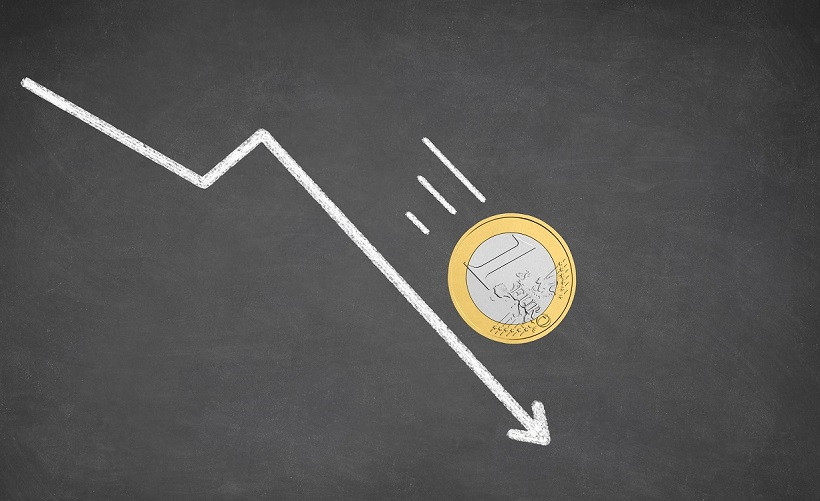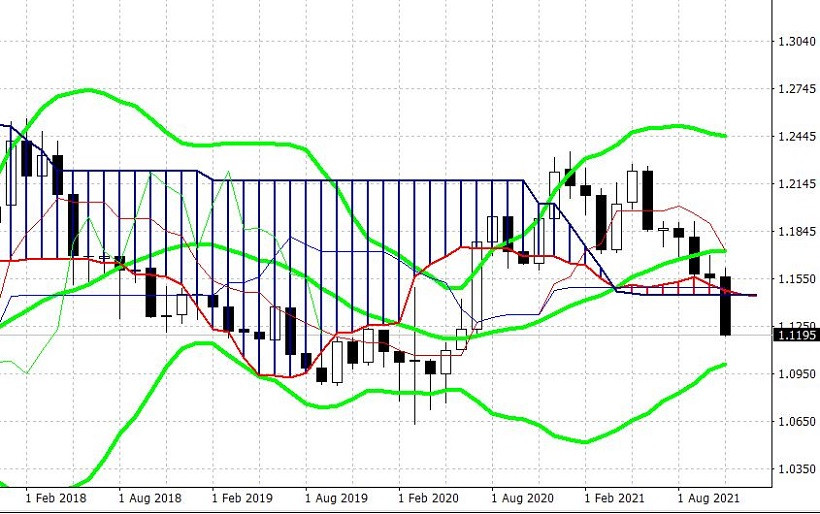The euro-dollar pair regularly updates the price lows of the year. Literally every day, EUR/USD bears move a kind of "flag," confirming the strength of the downward movement. On Wednesday, traders have already tested the area of the 11th figure.
For the first time since June last year, the euro has fallen so much against the greenback. And judging by the dynamics of the downward trend, the sellers of the pair are heading to the main support level, which is located at 1.1000 (the lower line of the Bollinger Bands indicator on the MN timeframe). Of course, we are talking about long-term prospects. Although even at the beginning of autumn, this target seemed so far away and unattainable.
Some experts warned about a possible collapse to this price point, but their forecasts looked too ambitious. To date, there is "nothing left" to the key and psychologically important level, less than 200 points. And if buyers do not hold the pair above the 10th figure, then it is difficult for them to break out from the bottom up, overcoming the resistance level of 1.1000.
As you know, such strong and protracted price movements should be treated with a certain degree of caution. After all, there is a very real risk of catching the "price bottom" by opening short positions on the eve of a trend reversal. And the closer the key support level of 1.1000, the higher the likelihood of such a scenario.
However, we must not forget that the EUR/USD pair is falling at such a pace for the first time since March 2020, when, in the wake of the coronavirus crisis, a fuss around the U.S. currency arose in the foreign exchange market.

Since then, such a sharp decline in the value of EUR/USD was observed only in June of this year, when, against the background of a jump in inflation in the United States, the pair fell from the 22nd figure to the area of the 18th price level. But, firstly, the pair did not continue to decline then, and secondly, over the next few months, it fluctuated in the range of 1.1700-1.1850.
At the moment we are dealing with a protracted and almost recoilless downside impulse. For four weeks, the pair has been consistently diving down, sweeping away all price barriers on its way. The price has not dropped below 1.1600 since July last year, not to mention lower values. Therefore, now we can speak with some confidence only about the 1.1000 target in the context of the endpoint of the current downside impulse.
Of course, there are intermediate price barriers on the way to reaching this level (for example, at the moment the bears are testing the 1.1200 mark, making temporary "forays" into the area of the 11th figure). But given the increasing demand for the greenback, against the background of a weakening euro, it is impractical to talk about them in the context of reliability.
The pair is diving down for several reasons. They can be conditionally divided into fundamental and "current" ones. The fundamental reason is the divergence of the ECB and the Fed rates. This is the main anchor that pulls EUR/USD to new price lows.
Even if we ignore the possible actions of Central Banks in the future and focus only on real steps, then the correlation is visible to the naked eye. The Fed has already begun to taper QE, while the European Central Bank, at the last meeting, ruled out the option of an early resolution of this issue: the Pandemic Emergency Purchase Programme (PEPP) will be completed next spring. Moreover, it is possible that after that the ECB members will increase the volume of the asset purchase program (APP).
As for the fate of the interest rate, the correlation is more pronounced here. The most influential members of the European regulator (in particular, Lagarde, Lane, Villeroy) ruled out the possibility of a rate hike before 2023. Whereas the Fed may raise the rate twice next year. Representatives of the "hawk wing" of the Fed, led by Bullard, are increasingly pointing out the existing risks of delay.
The current macroeconomic reports only fuel interest in the greenback. In particular, the most important inflation indicator - the main index of personal consumption expenditures - was published Wednesday. According to many experts, the indicator of the price pressure of consumer spending is "the most preferable" for the Fed members in the context of the analysis of inflationary processes. Therefore, Wednesday's data strengthened the position of dollar bulls: PCE Price Index rose to 0.4% on a monthly basis and to 4.1% on an annualized basis (this is the maximum since December 1990).
The dollar bulls were also pleased with the data in the field of the U.S. labor market. The growth rate of initial applications for unemployment benefits came out at the level of 199,000 (with the forecast of growth up to 260,000). This is, for a minute, a 52-year record. The last time the indicator was at such lows was back in 1969.
Additional support to the greenback was provided by Fed's Mary Daly, who announced that the regulator has every reason to accelerate the pace of QE tapering. Let me remind you that a similar thesis at the beginning of the week was voiced by her colleague, Christopher Waller. But Daly's case is special, as she was previously a consistent dove. In other words, the Fed's hawk wing has been replenished with another "fighter", and this fact is symbolic in itself.

Thus, it is impossible to talk about the risks of a trend reversal at the moment: the fundamental background contributes to the further strengthening of the U.S. currency, and, consequently, the further decline of the EUR/USD pair. Over the next day, the bears should settle within the 11th figure, after which the main target of the downward movement will be the psychologically important level of 1.1100.
The material has been provided by InstaForex Company - www.instaforex.com